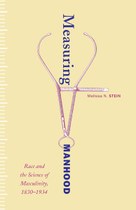Measuring Mahood Race and Science of Masculinity Review
Measuring Manhood
Race and the Scientific discipline of Masculinity, 1830–1934

A major new history of scientific racism in the United States
Covering a wide range of historical actors in nineteenth- and early twentieth-century America, Measuring Manhood analyzes how race became the purview of scientific discipline and reveals the role of gender, sex, and sexuality in the scientific making—and unmaking—of race.
Measuring Manhood is the book nosotros've been hoping for. For two generations, historians have talked near the ways that race, class, and gender are interlocking and co-operational. Carefully and thoughtfully, Melissa N. Stein gathers these plots and lays out a story of intersecting interests and ideologies: a story of knowledge gone mad that is deeply resonant in our time.
—
Matthew Pratt Guterl, Brownish University

From the "gay gene" to the "female brain" and African American students' insufficient "hereditary background" for higher education, arguments nigh a biological ground for human being difference have reemerged in the xx-offset century. Measuring Manhood shows where they got their start.
Melissa N. Stein analyzes how race became the purview of science in nineteenth- and early twentieth-century America and how it was constructed as a biological phenomenon with far-reaching social, cultural, and political resonances. She tells of scientific "experts" who advised the nation on its nearly pressing problems and exposes their utilize of gender and sexual practice differences to conceptualize or buttress their claims well-nigh racial deviation. Stein examines the works of scientists and scholars from medicine, biology, ethnology, and other fields to trace how their conclusions almost human being difference did no less than to legitimize sociopolitical hierarchy in the United states.
Covering a wide range of historical actors from Samuel Morton, the infamous collector and measurer of skulls in the 1830s, to NAACP leader and antilynching activist Walter White in the 1930s, this volume reveals the role of gender, sex, and sexuality in the scientific making⎯and unmaking⎯of race.

Melissa N. Stein is assistant professor of gender and women's studies at the Academy of Kentucky.

Measuring Manhood is the volume we've been hoping for. For two generations, historians have talked about the means that race, grade, and gender are interlocking and co-operational. Carefully and thoughtfully, Melissa N. Stein gathers these plots and lays out a story of intersecting interests and ideologies: a story of knowledge gone mad that is deeply resonant in our time.
—
Matthew Pratt Guterl, Brown University
Smartly conceptualized and engagingly written.
—
Journal of the History of Medicine and Allied Sciences
Measuring Manhood is well-written and complexly argued. It will be a useful text for courses in the history of medicine, gender, and sexuality studies; American history and scientific discipline and applied science studies. It provides an example of how to practise inter-
sectional analysis.
A masterful piece of work on the way racial theory, gender and science came together in the long nineteenth century.
—
Social History of Medicine
A noble effort to reveal the intersections of race, gender, and sexuality in the history of American science.
—
American Historical Review
Smartly conceptualized and engagingly written.
—
Journal of the History of Medicine and Centrolineal Sciences
A well-written narrative, Measuring Manhood is a welcome contribution to the histories of science and medicine, race, and sex and sexuality equally well to the interdisciplinary fields of American studies and gender studies.
—
Journal of American History
Anyone interested in how American science used studies of masculinity to aggravate social fears near race would exercise well to start with Measuring Manhood.
—
Journal of the History of Sexuality
Melissa Stein offers a meticulously researched history of biological essentialism. Her explicitly intersectional approach is a timely contribution to our agreement of how race and gender together informed the emerging sciences of ethnology, biology, and medicine from the nineteenth to the early twentieth century.
—
African American Review
Measuring Manhood is a sobering reflection on the fallacies of "objective" research and the office science has played in shaping social and political life. In this nowadays era of advanced genetic enquiry and considerable sociopolitical turmoil, this is a cautionary tale.
—
New Genetics and Society
Measuring Manhood is an excellent study of the development of the science of masculinity and its roots in race scientific discipline in the Us during the long nineteenth century.
—
Journal of American Ethnic History
Measuring Manhood is convincing and thoroughly engrossing from the showtime chapter to the final. Stein'south writing is engaging, vivid, and uncluttered.
—
Lateral: Periodical of the Cultural Studies Clan

Contents
Introduction: Making Race, Mark Difference
1. "Races of Men": Ethnology in Antebellum America
2. An "Equal Beard" for "Equal Voting": Gender and Citizenship in the Civil War, Reconstruction, and Redemption
3. Inverts, Perverts, and Primitives: Racial Thought and the American School of Sexology
4. Unsexing the Race: Lynching, Castration, and Racial Science
v. Walter White, Scientific Racism, and the NAACP Antilynching Campaign
Epilogue
Acknowledgments
Appendix. Charting Racial Science: Data and Methodology
Notes
Index
Source: https://www.upress.umn.edu/book-division/books/measuring-manhood
0 Response to "Measuring Mahood Race and Science of Masculinity Review"
ارسال یک نظر